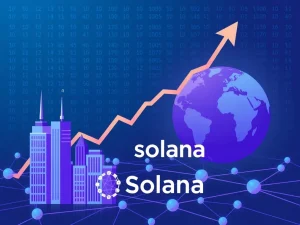Ethereum’s Explosive Ascent: Why $8,000 ETH Is Now a Realistic Target Amid M2 Growth and ETF Inflows

Get ready for some truly eye-popping predictions in the world of cryptocurrency! Imagine a prominent figure like Eric Trump, son of a former U.S. President, openly endorsing an $8,000 Ethereum price target. This isn’t just wishful thinking; it’s a sentiment echoed by seasoned crypto analyst Ted Pillows, and it’s rooted in significant macroeconomic shifts and undeniable institutional momentum. If you’re invested in the crypto space, or even just curious about its future, this convergence of factors could signal a truly transformative period for ETH.
Eric Trump and Ted Pillows: Unpacking the $8,000 ETH Price Target
The cryptocurrency community is buzzing after Eric Trump publicly aligned with crypto analyst Ted Pillows, suggesting that Ethereum (ETH) is significantly undervalued. Their bold prediction points towards an ambitious ETH price target of $8,000. This isn’t a random guess; it’s based on a compelling argument linking Ethereum’s valuation to global M2 money supply growth.
Ted Pillows, known for his incisive market commentary, asserted on X (formerly Twitter) that Ethereum’s valuation should inherently align with the rising tide of global liquidity. Eric Trump’s simple yet powerful endorsement – “I agree” – added considerable weight to this narrative. This collaboration brings a unique spotlight to a long-standing debate within crypto circles: how does traditional monetary expansion translate into digital asset valuations?
The Power of M2 Money Supply and Ethereum’s Potential
So, what exactly is M2 money supply, and why is it so crucial to this $8,000 prediction? M2 money supply is a broad measure of the amount of money in circulation, including cash, checking deposits, and easily convertible near money (like savings accounts and money market mutual funds). When the M2 money supply grows, it indicates more liquidity in the financial system, often leading to inflation and a search for assets that can absorb this excess capital.
Recent data underscores this trend: the U.S. M2 money supply hit a staggering $22.02 trillion in June 2025, marking a 4.5% annual increase. This represents the fastest growth rate observed since mid-2022. Historically, periods of surging liquidity have often correlated with upward movements in cryptocurrency prices. The argument put forth by Pillows and endorsed by Trump is that as this monetary environment expands, Ethereum, as a leading decentralized asset, is poised to capture a significant portion of this flowing capital. Pillows specifically suggests that an $8,000 valuation represents a fair target when considering these M2-M2 correlations.
While the historical correlation provides a compelling backdrop, it’s crucial to remember that this argument involves speculative assumptions. The direct translation of monetary policy into crypto market performance is influenced by numerous other factors, including evolving regulatory frameworks, technological advancements, and the broader adoption rates of blockchain applications.
Unprecedented Ethereum ETF Inflows: A Game Changer?
Beyond macroeconomic theories, concrete evidence of growing institutional confidence in Ethereum is manifesting through record-breaking Ethereum ETF inflows. The launch and subsequent performance of spot Ethereum Exchange-Traded Funds (ETFs) have been nothing short of phenomenal, signaling a maturing market and increased mainstream acceptance.
Consider these compelling statistics:
- On July 24th alone, Ethereum ETFs collectively saw $214 million in net inflows.
- This marked an impressive 15 consecutive days of positive inflow activity, demonstrating sustained institutional appetite.
- The iShares Ethereum Trust (ETHA) has been a standout performer, surpassing $10 billion in assets under management within a year of its launch. Its growth rate ranks as the fastest for an Ethereum-focused ETF and the third-fastest overall in U.S. history across all ETF categories.
- Other major players like Fidelity’s FETH and BlackRock’s Ethereum ETF have also attracted substantial capital, further underscoring the widespread institutional embrace of ETH as an investable asset.
These inflows are not just numbers; they represent a fundamental shift in how large financial institutions view Ethereum. They provide a regulated, accessible pathway for traditional investors to gain exposure to ETH, which historically has been challenging. This surge in institutional capital aligns perfectly with Ethereum’s recent price action, even as it navigates a consolidation phase near $3,600 after touching $3,900 earlier in the week.
Beyond $8,000? Other Bold ETH Price Targets
While the $8,000 target championed by Eric Trump and Ted Pillows has captured headlines, it’s part of a broader chorus of optimistic predictions for Ethereum’s future. Other prominent analysts and industry figures have offered their own ambitious forecasts, providing further context to the bullish sentiment surrounding ETH.
- Javon Marks: This respected crypto strategist has projected that Ethereum could first reach $4,811, representing a 27% increase from current levels. If bullish momentum persists, Marks even sees a potential surge to $8,557, which would signify a remarkable 75% upside. These targets are based on technical analysis and market patterns.
- Arthur Hayes: The co-founder of BitMEX, a highly influential voice in the crypto space, has suggested an even loftier target: $10,000 for Ethereum by year-end. Hayes’s projection is contingent on favorable global liquidity conditions and Ethereum’s pivotal role in the burgeoning decentralized finance (DeFi) ecosystem and the growing trend of tokenization. As more real-world assets and financial services migrate onto the Ethereum blockchain, its utility and value proposition naturally increase.
Such projections highlight the deep optimism about Ethereum’s fundamental strength, its technological superiority, and its critical position in the evolving digital economy. However, it’s essential for investors to distinguish these speculative forecasts from guaranteed market performance. While they paint an exciting picture, the actual price trajectory will always be influenced by a complex interplay of factors.
Navigating the Crypto Market Analysis: What’s Next for Ethereum?
The bullish case for Ethereum, fueled by M2 growth and robust Ethereum ETF inflows, is undeniably strong. Yet, a balanced crypto market analysis requires acknowledging the inherent volatility and the multitude of factors that can influence price movements. While Eric Trump’s endorsement reinforces existing narratives about Ethereum’s undervaluation, it doesn’t introduce new data to independently validate the $8,000 target; rather, it amplifies an existing, well-researched argument.
Several key variables will continue to shape Ethereum’s path:
- Macroeconomic Factors: Global inflation, interest rate decisions by central banks, and geopolitical stability will all play a role. A tightening of monetary policy, for instance, could reduce the liquidity that crypto assets thrive on.
- Regulatory Clarity: The ongoing development of clear and consistent cryptocurrency regulations across major jurisdictions remains critical. Positive regulatory frameworks can accelerate institutional adoption, while restrictive ones could hinder growth.
- Technological Adoption and Innovation: Ethereum’s continued evolution, including upgrades to its network (like scalability solutions) and the growth of decentralized applications (dApps) built on its blockchain, will underpin its long-term value.
- Competitive Landscape: While Ethereum is dominant, other layer-1 blockchains are constantly innovating and vying for market share. Ethereum’s ability to maintain its lead will be crucial.
The debate surrounding crypto’s role in a world of expanding money supply is intensifying, and Ethereum is uniquely positioned as a potential prime beneficiary of liquidity-driven capital flows. Its robust ecosystem, established network effects, and growing institutional acceptance make it a formidable contender in the race to redefine global finance.
Conclusion: Ethereum’s Horizon – A Blend of Optimism and Caution
The confluence of an expanding M2 money supply, unprecedented Ethereum ETF inflows, and high-profile endorsements from figures like Eric Trump and seasoned analysts such as Ted Pillows, paints an incredibly optimistic picture for Ethereum. The prospect of an $8,000 ETH price target, or even higher, is no longer a fringe idea but a serious consideration within financial circles. Institutional confidence is soaring, providing regulated avenues for significant capital to enter the market, and the underlying macroeconomic conditions appear favorable for assets that can absorb increasing global liquidity.
However, as with any investment in the dynamic crypto space, caution remains paramount. While the bullish arguments are compelling, the journey to $8,000 (and beyond) will likely be marked by volatility, influenced by global economic shifts, regulatory developments, and the continuous evolution of the blockchain landscape. For those watching Ethereum, the current period represents a fascinating intersection of traditional finance and cutting-edge digital assets, promising an exciting future for the world’s leading smart contract platform.
Frequently Asked Questions (FAQs)
Q1: Who are Eric Trump and Ted Pillows, and what is their Ethereum price target?
Eric Trump, son of former U.S. President Donald Trump, and crypto analyst Ted Pillows are prominent figures who have publicly stated their belief that Ethereum (ETH) is significantly undervalued. They have put forth an ambitious price target of $8,000 for Ethereum, based primarily on the growth of the global M2 money supply.
Q2: How does M2 money supply growth influence Ethereum’s valuation?
M2 money supply refers to the total amount of money in circulation, including cash, checking deposits, and easily convertible funds. When M2 grows, it indicates increased liquidity in the financial system. Proponents argue that as more money enters the system, assets like Ethereum, with their finite supply and growing utility, become attractive destinations for capital, potentially driving up their value to absorb this excess liquidity.
Q3: What is the significance of recent Ethereum ETF inflows?
Recent Ethereum ETF (Exchange-Traded Fund) inflows are highly significant as they demonstrate strong and sustained institutional confidence in ETH. ETFs provide a regulated and accessible way for traditional investors and large institutions to gain exposure to Ethereum without directly holding the cryptocurrency. Record inflows, like the 15 consecutive days of positive activity and iShares Ethereum Trust (ETHA) surpassing $10 billion in AUM, indicate a major shift towards mainstream acceptance and capital deployment into the Ethereum ecosystem.
Q4: Are there other notable Ethereum price predictions beyond $8,000?
Yes, several other analysts and industry leaders have offered ambitious Ethereum price predictions. Crypto strategist Javon Marks has predicted ETH could reach $4,811 and potentially $8,557. Arthur Hayes of BitMEX has even suggested a $10,000 target by year-end, contingent on favorable liquidity conditions and Ethereum’s continued dominance in decentralized finance (DeFi) and tokenization.
Q5: What are the main risks or considerations for Ethereum’s price trajectory?
While the outlook is optimistic, Ethereum’s price trajectory is still subject to several risks and considerations. These include broader macroeconomic factors (like interest rates and inflation), evolving regulatory developments globally, competition from other blockchain platforms, and the pace of technological adoption and network upgrades. While institutional inflows are strong, they do not guarantee specific price targets.










